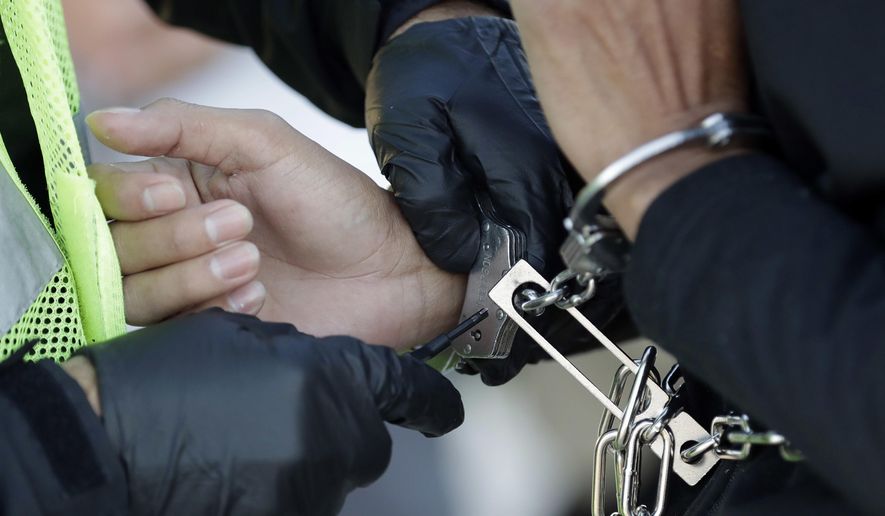A shocking violent attack at a California church has local leaders demanding a rethink of sanctuary policies Wednesday after the suspect was revealed to be an immigrant with a lengthy criminal record and multiple deportation requests from ICE, all of which were refused.
Fernando De Jesus Lopez-Garcia, who is in the country illegally, had a nearly 15-year rap sheet including disturbing the peace, lying to police, resisting arrest, assault with a deadly weapon and felony domestic violence.
In just the last two years, jail officials in two different counties ignored three detainer requests from U.S. Immigration and Customs Enforcement, including one as recently as June.
On Sunday, police say, Mr. Lopez-Garcia was free on the streets and likely high on methamphetamine when he stabbed five people at a Baptist church that also runs a homeless shelter in San Jose. He now faces two counts of murder and three counts of attempted murder.
San Jose Police Chief Eddie Garcia said it’s the latest violent attack by someone who could have been deported by ICE, but was instead protected by local sanctuary policies.
“How many incidents does it take? How many lives does it take to institute some change?” he demanded at a press conference Wednesday.
California has one of the country’s marquee sanctuary policies, severely limiting cooperation with ICE, but Santa Clara County’s restrictions go even further.
Chief Garcia said that because of Mr. Lopez-Garcia’s criminal record, state law would have allowed local authorities to notify ICE of his release. Under the county’s even stricter policy, however, local authorities are prohibited from tipping off ICE.
So ICE wasn’t notified of Mr. Lopez-Garcia’s release in June after his latest domestic violence case.
“Here we have catastrophic proof of the abject failure of California’s sanctuary policies,” said David Jennings, director of ICE’s deportation operations in its San Francisco field office. “The only person this policy protected was a criminal; permitting him to reoffend over and over again.”
He said if any of the three detainer requests ICE had placed on Mr. Lopez-Garcia over the last couple years had been honored, he could have been removed from the streets.
“These are deaths that likely could have been prevented had local law enforcement cooperated with ICE,” Mr. Jennings said.
Local officials said there were other opportunities beyond deportation to stop the stabbings.
Better services for the homeless — Mr. Lopez-Garcia himself was “unhoused,” as were several of his victims, local officials said — and more readily available drug treatment might have helped.
So, too, would a less lenient criminal justice policy, said San Jose Mayor Sam Liccardo.
Mr. Lopez-Garcia was arraigned in June on misdemeanor domestic violence charges, at a time when he was already on probation for a felony domestic violence charge. Prosecutors argued he should be kept behind bars pending trial, but the judge released him without bail.
“We cannot avoid the conclusion that this was preventable,” Mr. Liccardo said.
He suggested the rights of the accused have come to trump the rights of victims and community safety.
“Changes in our criminal justice system have not made our community safer. This pendulum has swung too far,” he said.
He, like Chief Garcia, said the county’s sanctuary policy was also to blame.
“In those very rare circumstances where an undocumented offender has a record of violent or serious prior convictions, the county should be acting in accordance with the state’s Values Act and notifying ICE that a person will be released out into the community unless ICE responds,” the mayor said.
Santa Clara County supervisors pondered changes last year, after a San Jose mother was killed in her home and police arrested an undocumented immigrant who’d been repeatedly protected by the county’s sanctuary policy. But the supervisors left the strict noncooperation policy in place.
The county has also fought President Trump in court and prevailed, defeating his attempt to punish sanctuary cities by stripping funding.
Mr. Liccardo said in addition to last year’s murder and this weekend’s stabbings, there were “several other serious crimes” where ICE should have been notified but wasn’t, thanks to the sanctuary policy. He said those crimes didn’t “make the news cycle.”
He and Chief Garcia both said in the wake of the killings, it’s time for another rethink.
“This suspect had a long record of domestic violence and drug use, and he should have been in jail, in federal custody, in drug treatment or in jail in his own country, but not on the streets in our community,” the mayor said.
The number of sanctuary communities has soared under the Trump administration as local politicians seek to show resistance to Mr. Trump’s stricter immigration enforcement.
But along with that increase have come a number of high-profile killings, spanning the country.
King County, which includes Seattle, saw two murders laid at the feet of undocumented immigrants last year. In one, a 16-year-old student had his head bashed in with a bat, then was chopped apart with a machete.
Across the country in Prince George’s County, Maryland, authorities released several undocumented immigrants who would go on to be accused of multiple gang-related murders, including one stabbing this summer in Baltimore.
Neither jurisdiction has revisited its sanctuary policy.
• Stephen Dinan can be reached at sdinan@washingtontimes.com.




Please read our comment policy before commenting.